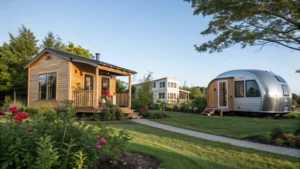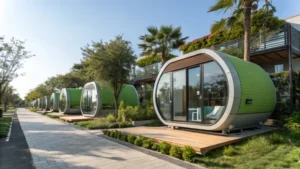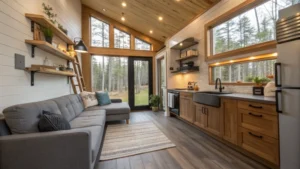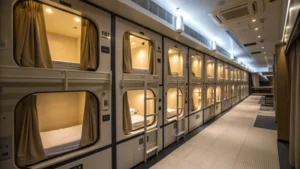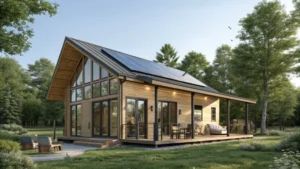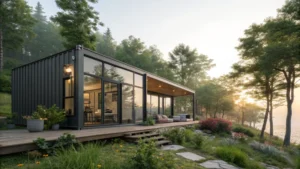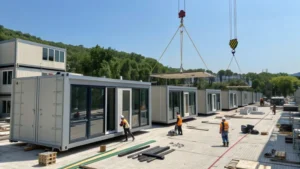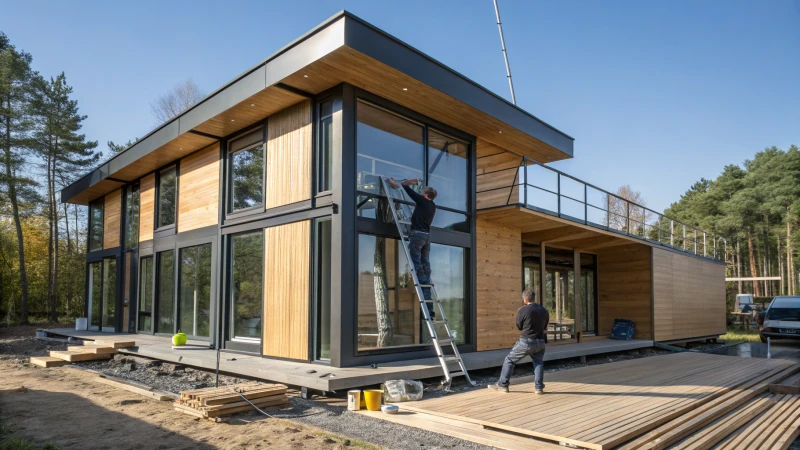
Ever wondered what it's really like to dive into the world of prefabricated homes? Let's break down the costs so you know exactly what you're getting into.
When buying and building a prefabricated house, expect costs to range from $50,000 to over $250,000. This estimate includes the base home price, customizations, land purchase, site prep, installation, and utilities and permits.
Taking a journey into the prefab world involves understanding each cost component intimately. From that exciting moment you choose your home style to the nitty-gritty of securing permits, these costs can shape your dream home. Let's explore how each factor contributes to your overall budget so you can plan with peace of mind.
Prefabricated homes cost less than traditional homes.True
Prefab homes often have lower costs due to efficient manufacturing and assembly.
Land acquisition is included in prefab home base price.False
Land acquisition is a separate cost from the prefab home's base price.
How do base costs vary for prefabricated homes?
I still remember the excitement and confusion when I first explored the world of prefabricated homes. Why did the prices vary so much?
Base costs for prefabricated homes vary due to factors like size, design complexity, materials, and site preparation. Smaller models are cheaper, while larger, custom homes with premium features cost more.
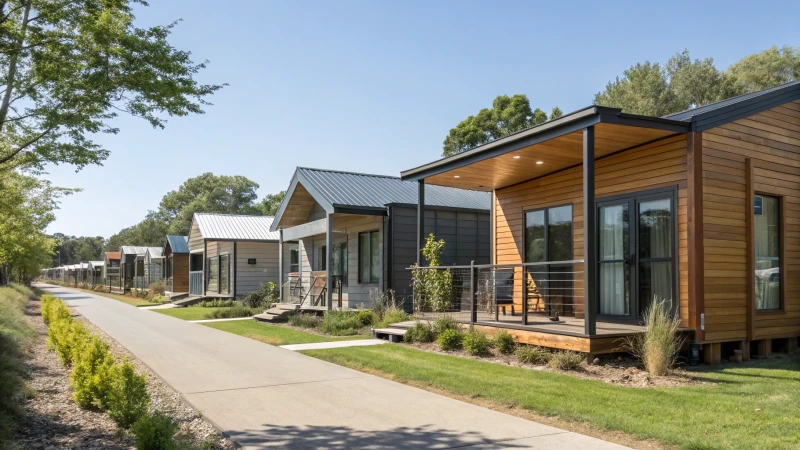
Size and Design Complexity
When I first dipped my toes into the prefab home market, I was blown away by how size and design could shift prices. Imagine walking through a cozy 1,000-square-foot home and feeling its compact charm, versus stepping into a 2,500-square-foot marvel with room for everything from a home office to a yoga nook. Naturally, the latter will stretch your budget more. In my case, the smaller models were within the $50,000 to $120,000 range, while the larger ones went upwards of $200,000. Plus, if you're dreaming of unique architectural features like a rooftop garden or an intricate facade, brace yourself for additional costs due to the engineering involved.
Material Quality and Features
Choosing the right materials felt like picking toppings for a pizza—each choice impacted the overall taste and price. Basic materials keep costs down, but if you’re like me and fancy high-end finishes such as hardwood floors or cutting-edge smart home technology1, be ready for costs to climb by 20%-50%. Adding bespoke elements like an extra room or a sunlit reading corner? That’s an investment in your comfort and style.
Site Preparation and Land Costs
One of my biggest revelations was how much land and site prep could cost. Whether nestled in a bustling city or secluded nature spot, land prices swing between $10,000 to $200,000. I learned that clearing and leveling can add another $5,000 to $30,000 to your expenses. Especially if you're in a remote area like I once considered for an eco-retreat—getting materials there could skyrocket costs due to logistical hurdles.
Installation and Utility Connections
Installation was another eye-opener. Depending on how straightforward or complex the setup is—say just a slab foundation versus a full basement—it could range from $5,000 to $20,000. Don’t forget utility hookups; connecting to water, electricity, and sewage set me back an additional $5,000 to $15,000. But seeing it all come together felt like building my own dream from scratch.
Cost Breakdown Table
| Cost Component | Price Range |
|---|---|
| Land | $10,000 - $200,000 |
| Site Preparation | $5,000 - $30,000 |
| Installation | $5,000 - $20,000 |
| Foundation | Variable |
| Utility Connections | $5,000 - $15,000 |
Economies of Scale
I stumbled upon a great tip—buying in bulk can lead to huge savings. For larger projects like resorts or communities discounts of 10%-30% aren’t uncommon. It’s a strategy I’ve seen many developers use to cut costs while maintaining top-notch quality.
Exploring these factors—from size and design intricacies to bulk purchase benefits—helped me piece together how prefab home costs fluctuate. Delving into resources like prefab home guides2 gave me the confidence to align my choices with both my financial plan and personal style.
Complex designs increase prefab home costs.True
Complex designs require more materials and engineering, raising costs.
Land costs for prefab homes are always under $100,000.False
Land costs can vary widely, ranging from $10,000 to $200,000.
What Extra Costs Should I Expect with Customizations?
Thinking about customizing your dream project? Let's dive into the extra costs you might encounter along the way.
When customizing, expect additional costs like design fees, premium materials, and longer timelines. These include increased expenses for specialized labor, project management, and potential ongoing maintenance needs.

Design and Development Fees
When I first decided to customize my home, I was surprised by how quickly design fees3 added up. Engaging an architect to bring my unique vision to life wasn't just about the initial sketches; it involved endless revisions and back-and-forths. Whether you're hiring a professional to craft bespoke software or design your dream house, these costs can be significant.
Premium Materials and Features
Opting for high-end finishes was another area where costs escalated. I recall choosing beautiful hardwood flooring instead of laminate for its timeless appeal, only to realize the price tag matched its elegance. This goes for custom features too—think of installing smart home systems that enhance both functionality and value.
Here's a quick breakdown:
| Material Type | Cost Increase (%) |
|---|---|
| Basic to Premium | 20%-50% |
| Standard to Custom | 30%-70% |
Project Management and Specialized Labor
Coordinating a customized project required a team of skilled workers, which, of course, came at a premium. Each specialist—from electricians to carpenters—brought their expertise, ensuring everything aligned perfectly. Plus, managing all these moving parts meant additional project management costs4.
Extended Timelines and Potential Delays
If you've ever lived through a renovation or a software rollout, you know timelines often stretch beyond what you initially planned. We had to budget for temporary accommodations when our home project ran over schedule. Similarly, missing deadlines might mean financial penalties if not pre-agreed in contracts.
Maintenance and Upkeep Considerations
Custom elements often require unique upkeep. I learned this lesson the hard way when our high-end kitchen countertops needed special cleaners. Planning for ongoing maintenance in your budget can prevent unexpected expenses later on.
For more real-world insights, check out community discussions on Reddit5. These stories offer valuable lessons from others who've navigated similar customization journeys.
Customizations always increase project costs.True
Customizations involve design fees, premium materials, and specialized labor.
Extended timelines rarely affect customization projects.False
Custom projects often face delays, affecting timelines and costs.
How Do Land and Site Preparation Costs Impact Your Budget?
Picture this: you're all set to build your dream project, but the land preparation costs throw a wrench in your plans. Here's why understanding these expenses is crucial.
Land and site preparation costs can significantly influence your project's total expenses, typically ranging from $5,000 to $30,000 depending on the site conditions. Accurate planning and estimation are key to managing your budget effectively and avoiding unexpected financial surprises.

Understanding Land Costs
When I first ventured into construction, I was astounded by how much land prices could vary. Location is everything! A prime spot in the city might break the bank compared to more rural areas. This difference really hits home when you consider factors like accessibility and amenities. It's not just about finding a piece of land; it's about finding the right piece of land for your needs.
Factors such as location, accessibility, and size play a critical role in determining land prices. For instance, acquiring land in urban areas tends to be more expensive than in rural locations due to demand and available amenities6.
Site Preparation Components
I remember the first time I tackled site preparation—it was a learning curve! Whether it's clearing trees or leveling hilly terrain, each step adds up. I once underestimated a rocky plot, thinking it was just a minor hurdle. Spoiler alert: it wasn't! An early site assessment is crucial to avoid those "I didn't see that coming" moments.
Site preparation involves clearing, leveling, and grading the land, each contributing differently to costs. The complexity of the terrain significantly impacts expenses; rocky or heavily forested sites require more resources compared to flat, open land.
| Site Condition | Estimated Cost Range |
|---|---|
| Flat/Minimal Clearing | $5,000 - $10,000 |
| Moderately Complex | $10,000 - $20,000 |
| Highly Complex | $20,000 - $30,000 |
The Role of Permits and Regulations
Navigating local regulations can feel like walking through a maze. Once, I was all set to start construction when I discovered that additional permits were needed—talk about a setback! Understanding local zoning laws7 beforehand can save you both time and money.
Local building codes and regulations often necessitate permits before construction can commence. These permits vary by jurisdiction and can significantly affect timelines and budgets.
Utilities and Infrastructure Setup
Connecting utilities can be straightforward if you're lucky enough to have existing infrastructure nearby. But I've worked on remote sites where off-grid solutions were the only option, significantly impacting costs. Exploring alternative utility solutions8 early on can lead to smarter budget decisions.
Connecting utilities like water, electricity, and sewage to the site represents another significant cost factor. Proximity to existing infrastructure can reduce these expenses.
Mitigating Unexpected Costs
To avoid those dreaded surprises, thorough planning is my go-to strategy. Employing experienced contractors and leveraging project management tools have been game-changers for me. They help keep everything on track from resource allocation to timeline adherence9. In this business, a little foresight goes a long way.
Conducting thorough site surveys and employing experienced contractors can lead to more accurate estimates.
Urban land is cheaper than rural land.False
Urban land is typically more expensive due to higher demand and amenities.
Complex terrain increases site preparation costs.True
Rocky or forested sites need more resources, raising preparation costs.
What Are the Ongoing Maintenance Expenses for Prefab Homes?
Imagine owning a prefab home that's not only eco-friendly but also budget-savvy. But what about keeping it in tip-top shape?
Ongoing maintenance expenses for prefab homes typically range from $1,000 to $5,000 annually, covering regular inspections, repairs, HVAC servicing, and energy efficiency upgrades. The costs depend on the home's size and location, ensuring your investment stays sustainable and efficient.
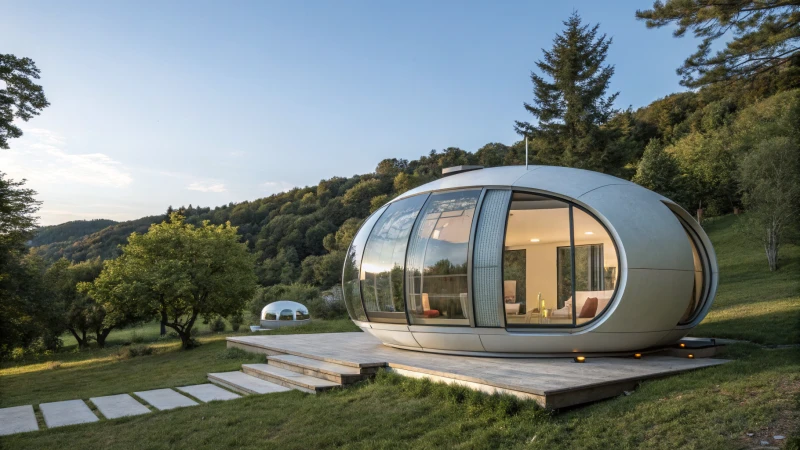
Routine Inspections and Repairs
Every home has its quirks, and prefab homes are no different. I remember the first time I realized the importance of routine inspections; a small leak in the roof of my prefab abode quickly escalated to a bigger issue just because I delayed checking it out. This taught me the value of catching problems early. Regular inspections for water damage or wear and tear on siding can save you from unexpected headaches.
- Annual Inspection Cost: Typically between $200 and $500.
- Common Repairs: Roof patching or siding repair can cost $500 to $2,000.
If you live in an area with frequent heavy rainfall, keeping an eye on water damage10 is especially crucial. It’s these small preventive measures that keep the peace of mind intact.
HVAC System Servicing
Our heating and cooling systems are like the unsung heroes of our homes. Regularly servicing the HVAC system is something I learned to prioritize after a particularly chilly winter night when the heater decided to take a break. It turned out, a simple filter replacement could have prevented the issue.
- Annual Servicing Cost: Around $100 to $300.
- Potential Repairs: Replacing parts like filters or thermostats can add another $100 to $500.
Investing in energy-efficient11 systems may initially seem costly, but they pay off by reducing future maintenance expenses.
Energy Efficiency Upgrades
Prefab homes are often touted for their energy efficiency, but older models might need a bit of sprucing up. I’ve found that insulating your home better not only keeps you comfortable but also trims down those pesky energy bills.
- Insulation Enhancements: Can range from $1,000 to $3,000.
- Solar Panel Installation: Although an initial investment of $10,000 or more, it can significantly reduce energy bills.
Exploring solar panels12 can be a substantial yet worthwhile investment if you’re looking at long-term savings.
| Maintenance Task | Estimated Cost |
|---|---|
| Routine Inspections | $200 - $500 annually |
| Roof and Siding Repair | $500 - $2,000 as needed |
| HVAC Servicing | $100 - $300 annually |
| Energy Upgrades | $1,000 - $3,000 |
Regional Cost Variations
Living in different regions brings unique challenges. From my experience moving from sunny California to humid Texas, I learned firsthand how climate can affect maintenance needs. Homes in each region face distinct challenges due to weather patterns, impacting how you budget for upkeep.
Researching local home maintenance trends13 can provide valuable insights into what expenses you might encounter based on your specific area. It’s all about staying one step ahead so that your home remains a sanctuary rather than a stressor.
Annual inspection cost for prefab homes is $200 to $500.True
The content specifies routine inspections costing between $200 and $500.
Solar panel installation on prefab homes costs under $5,000.False
The content states solar panels cost $10,000 or more initially.
Conclusion
Buying and building a prefabricated house involves costs from $50,000 to over $250,000, influenced by size, design complexity, land acquisition, site preparation, and customization.
-
Explore advanced smart home technologies that enhance living experiences in prefab homes. ↩
-
Find guides that help you choose the right prefabricated home tailored to your needs. ↩
-
Explore typical costs and strategies for managing design fees in customized projects. ↩
-
Learn how project management expenses can increase with customizations and ways to budget for them. ↩
-
Gain insights from real-world experiences shared by individuals handling customization costs. ↩
-
This link explains how various factors like location and demand influence land prices, offering insight into strategic land purchases. ↩
-
Understanding zoning laws is crucial for compliance and budgeting; this link details their implications on construction projects. ↩
-
Explore this link for innovative utility solutions that could reduce setup costs for remote sites. ↩
-
Learn about tools that enhance budget management and ensure timely project completion by visiting this link. ↩
-
Learn essential strategies to protect your prefab home from water-related issues. ↩
-
Discover how an energy-efficient HVAC system can save money on maintenance. ↩
-
Find out how solar panels can lead to long-term savings on energy costs. ↩
-
Understand how maintenance costs vary by region to better plan your budget. ↩



